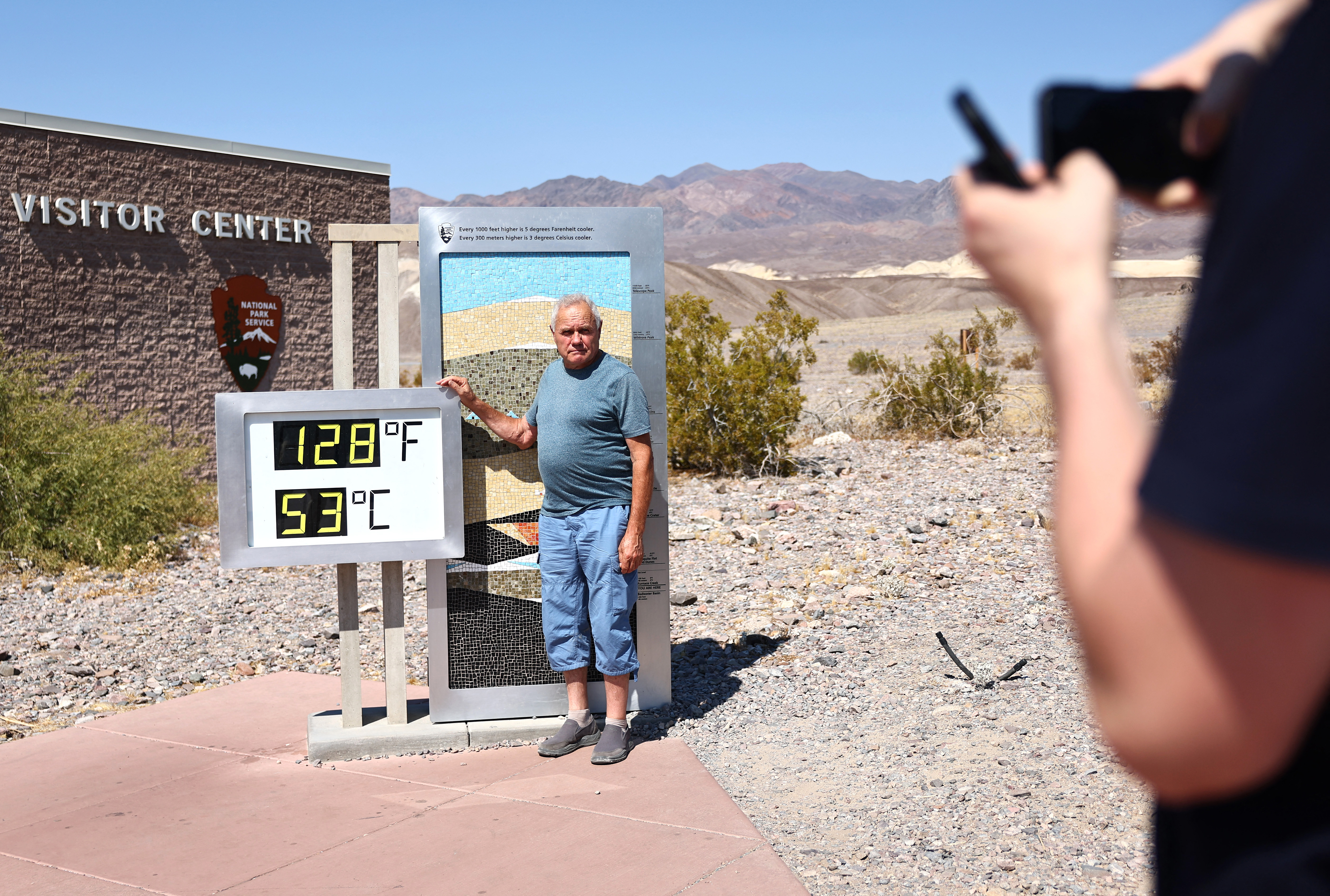
Imagine standing under the blazing hot sun, sweat dripping down your back, and your shirt sticking to your skin as you walk to classes.
Just the thought of it makes you feel icky, doesn’t it?
Those living in the hottest places on Earth can vouch for how uncomfortable the heat can be.
However, it’s no surprise that those who don’t live there seek to visit these (oftentimes) tropical spots for a nice sunny getaway by the beach or even to escape the cold winters or terrible weather of their own countries.
Still, adjusting to the heat can overwhelm international students, especially those from colder-climate countries such as Canada, Finland, and Norway.

Unfortunately, it’s frowned upon to jump into a fountain to cool off if you’re not a dog. Source: AFP
What happens in extreme heat?
Extreme heat can cause heat-related illnesses such as heat stroke or heat exhaustion. At worst, exposure to extreme heat could even cause death.
According to the World Health Organisation, “the strain put on the body as it tries to cool itself also stresses the heart and kidneys. As a result, heat extremes can worsen health risks from chronic conditions such as cardiovascular and respiratory conditions and cause acute kidney injury.”
The New York Times reported that more than 1,000 hajj pilgrims in Saudi Arabia have died in 2024 due to intense heat as temperatures surpass 37.7°C (100°F).
Another report by The New York Times states that at least 125 young attendees of the 25th World Scout Jamboree from the UK, Singapore, and the US have been hospitalised for heat exhaustion while hundreds are exhibiting heat-related symptoms.
In school, extreme heat means students perform worse academically.
A 2018 study found that cumulative heat exposure decreases the productivity of instructional time — without school air conditioning, a 1-degree hotter school year reduced that year’s learning by 1%.
People are also more aggressive and violent when it’s hot outside, leading to experts saying that extreme heat could extend to higher rates of bullying among students, according to research from 2014.
It’s suffice to say that extreme heat is dangerous. However, it should not stop you from travelling to hot places.
For those planning on travelling or studying to one of the hottest places on Earth, remember to take safety measures to avoid heat strokes or dehydration.
According to the US Centres for Disease Control and Prevention (CDC), you can protect yourself from extreme heat by:
- Drinking plenty of fluids even when you don’t feel thirsty
- Wearing loose and lightweight clothes
- Pacing yourself during activities, especially if you’re outdoors
- Checking the local news for health and safety updates
- Taking cool showers cool down
Coldest places on Earth
If none of the above suggestions work, you might want to plan a trip to the coldest places on Earth.
- It’s no secret that Antarctica tops this list, with average temperatures dropping as low as -57°C (-70.6°F) and at -90°C (-130°F) during winter.
- Alaska is the coldest states in the US, with average temperatures going as low as -34°C (-30°F) during the winter months. In Denali, Alaska, temperatures can drop to -73.8°C (-100.8°F).
- Snow-covered Russia sees temperatures reaching as low as -42ºC (-44ºF), though the average temperatures range between -3ºC (25ºF) and -9ºC (14ºF).
- Let’s not forget Sakha (Yakutia), Siberia, the coldest inhabited city on Earth. The lowest recorded temperature is -62.7°C (-80.9°F), 60% lower than kitchen freezers.

In the Southern Hemisphere, Australia is known for its extreme heat throughout the country during its summer months. Source: AFP
10 hottest places on Earth, and the universities around them
1. Onslow, Australia
Temperature: 50.7°C (123.2°F)
Located in western Australia, Onslow is one of the hottest places on Earth and in the Southern Hemisphere.
The highest temperature recorded was 50.7°C (123.2°F) on January 13, 2022. The average temperature during the day is 32.2°C and can reach 37°C.
The cause of the heat is due to a build-up of hot air along the coast.
Luckily for international students, Onslow doesn’t have any universities in the area. The closest universities located to the town are:
2. Jeddah, Saudi Arabia
Located by the coast of the Bridge of the Red Sea, this Saudi Arabian port city is known for its historical landmarks and status as one of the hottest places on Earth.
The highest temperature recorded in Jeddah was 52°C (125.6°F) on June 22, 2010. During the hottest months, the temperature can average about 34°C (93.2°F).
The geographical location and the Red Sea affect Jeddah’s temperature slightly.
Despite its hot weather, Jeddah is home to one of the best universities in the Middle East, including:

Aerial view of salt layers left by the Sea of Cortez near Mexicali, Baja California state, Mexico. Source: AFP
3. Mexicali, Mexico
Nestled in the northern part of Baja California and the US border, this capital city is famously known as “the city that captures the sun” due to its high temperatures.
On July 28, 1995, Mexicali’s temperature reached 52°C (125.6°F), making it one of the hottest places on Earth. In recent years, the capital city’s high temperatures range from 20.5°C (69°F) to 44°C (111.2°F). The hottest months can last from April to November.
Due to its geological location above the Cancer Tropic, Mexicali experiences low rainfall, which makes it hot and dry.
Minus the scorching heat, you can find good universities in its area:
4. Al Jazeera Border Gate, UAE
A four-hour drive from Dubai, Al Jazeera Border Gate has found its place on the list of one of the hottest places on Earth.
On July 2002, Al Jazeera’s highest recorded temperature reached 52.1°C (125.8°F). The months of July and August can soar up to 48°C (118.4°F) and sometimes even get 50°C (122°F).
The humidity also intensifies the heat, making hot days even hotter.
Still, those who want to enjoy the city’s iconic skyline views despite the heat can enrol in these universities:
5. Turbat, Pakistan
Turbat is a city in southern Balochistan, Pakistan, known for its Baloch folklore and literature.
The World Meteorological Organization confirmed that the highest temperature recorded in Turbat was 53.7°C (128.7°F) on May 28, 2017. It was then listed as the 4th hottest temperature recorded on Earth.
The district’s yearly temperature is 5.8% higher than Pakistan’s average, reaching about 26.7ºC (80.1ºF).
If you’re not too bothered by the heat, the University of Turbat can be a place to explore and further your studies.

In Basra, Iraq, the city suffers from water scarcity and reduced rainfall, contributing to the city’s heat levels. Source: AFP
6. Basra, Iraq
Basra is a city in southern Iraq. It is the third-largest city in the country after Baghdad and Mosul.
On July 22, 2016, Basra reached its all-time high temperature, 53.9°C (129°F). In recent years, the city’s high temperatures can reach up to 46.6°C (116°F), with the hottest months being from the end of May to the start of September.
Al Jazeera says water scarcity, desertification, reduced rainfall, and climate change are the few causes of Basra’s extreme heat.
With its geological location, the universities in Basra are known for their Petroleum Engineering and Marine Science programmes.
7. Mitribah, Kuwait
Mitribah in Kuwait holds the title for highest temperature ever recorded for the continental region of Asia.
According to Gulf News, “Kuwait’s proximity to the equator makes the country prone to higher temperatures and attracts more solar radiation. The combination of low vegetation and increased buildings contributes to the rising temperatures.”
The World Meteorological Organization recorded Mitribah’s highest temperature at 53.9°C (129°F) on July 21, 2016. The following year, on May 28, 2017, temperatures reached 53.7°C (128.6°F). During the summer, from June to August, temperatures average around 47°C (116.6°F) during the day and 30°C (86°F) at night.
Despite its hot weather, Kuwait is home to several local and international universities:
8. Ahvaz, Iran
Located in the Central District of Ahvaz County, Khuzestan Province of Iran, Ahvaz is a melting pot of cultures. It is home to several ethnic groups, including Arabs, Baktiari, and Persians.
On June 29, 2017, the city’s temperatures reached a scorching 54°C (129.2°F). The average daily temperature in Ahvaz is 38.3°C (101°F).
The extreme heat in Ahvaz is due to poor air quality and planning. Factory emissions, traffic fumes, and dust storms contribute to poor air quality. According to IQAir, the air quality in Ahvaz is unhealthy for individuals with asthma.
Despite this, the city is dedicated to educating its citizens. Here are a few universities in its surrounding area:
- Ahvaz Jundishapur University of Medical Sciences
- Shahid Chamran University of Ahvaz
- Islamic Azad University
9. Qibilī (Kebili), Tunisia
Located in the south of Tunisia, Africa, the hottest temperature in the continent was recorded in Qibilī, at 55°C (131°F), on July 7, 1931.
Thankfully, the city’s average temperature is 26.6°C (80°F) during the hot months, from late June to the middle of September.
The city’s hot temperatures are due to its northern mountainous ranges close to the Sahara Desert. There aren’t many universities nearby, but if you’re determined to attend a university here, there’s the University of Gabes which is bit of a drive away.

Due to its extreme heat in the Death Valley, a number of visitors have died from heat-related issues, as well as many getting hospitalised. Source: AFP
10. Death Valley, California, US
The place’s name summarises how bad the heat gets, and it’s predicted to beat its record as number one on the list of hottest places on Earth.
The temperature at Death Valley was 56.7°C (134°F) in July 1931, the hottest temperature ever recorded on Earth. The average summer temperature at Death Valley often rises above 45°C (113°F).
A Quora user who has been to Death Valley says, “It was quite hot there, but also notably dry, so much so that as we were eating sandwiches before finishing one, the bread had more or less turned into toast.”
When visiting, it is advised to exercise safety caution as the heat can cause heat-related illnesses when not careful. According to The Guardian, one visitor died due to heat exposure, while another was hospitalised while travelling in Death Valley on July 8, 2024.
While there are no universities in Death Valley itself, there are a few universities in its surrounding area:

Despite the hot weather in Greece, visitors still flock to the country for the holidays. Source: AFP
Honourable mentions
1. Hottest in Europe: Athens, Greece
The World Meteorological Organisation recorded the highest temperature of 48.0°C (118.4°F) on July 10, 1997, in Athens, Greece. It was the hottest temperature ever recorded in Europe.
2. Hottest in Southeast Asia: Chauk, Myanmar
Chauk, Myanmar, takes the top spot for the hottest place in SouthEast Asia at 48.2°C (118.7°F) on April 28, 2024.
3. Hottest island: Jamaica, Caribbean
Jamaica is the hottest island on Earth, with a record of 39.1°C (102°F).











